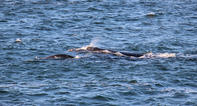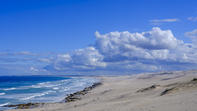Southern Right Whales
At the upper limit of the intertidal area of the De Hoop Nature Reserve are shellfish living in a stressful habitat that alternates pounding waves with searing winds and burning sun. But the brown mussels, various limpets, barnacles and oysters seem quite content to stay here.

Between June and December, the Southern right whales that breed in South African waters do so between Arniston and Infanta - watch the swells just behind the breaker line and you are bound to see them. They were said by whalers to be the 'right' whales to hunt because of the high oil and bone yield, and because they did not sink when harpooned. Since the mid-19th century, however, whale populations have been mercilessly cut and today there are only about 5 000 of this species left, 750 of which breed off our coast.
The whales can usually be seen with their calves about 500 m offshore, blowing a V-shaped spray into the air. Southern right whales have been protected since 1935, and only now do their numbers seem to be increasing.
The whales, which reach a length of 28 m and weigh up to 55 tons, feed on krill (small shrimp-like crustaceans) in sub-Antarctic waters from late summer to autumn, before moving north to breed. Walker Bay is also an important fishing area, however, and there is much concern among whale lovers that trawlers and pleasure boats disturb the whales when breeding and nursing.
Also, the controversial use of trawling nets in the bay is said to be harmful to pelagic fish population dynamics, as well as to porpoises, seals and other marine animals that get caught in these nets and drowned.
Sandy Beach Ecosystem

A healthy sandy beach has been likened to a vast respiratory and digestive system that circulates water and air through its wedge-shaped filter, processes organic matter on it and returns it to the sea in basic form as food for other creatures. Most of the animal life of a sandy beach ecosystem is less than one millimetre long, living between the sand grains.
As the water level, food supply, oxygen and other levels fluctuate, these animals (called meiofuana) can migrate within the beach sand to locate an optimal environment. Also, the controversial use of trawling nets in the bay is said to be harmful to pelagic fish population dynamics, as well as to porpoises, seals and other marine animals that get caught in these nets and drowned.
Along much of the bay of Jessie se Baai, the shore is traced by a line of calcrete cliffs, where limestone from shell deposits has been leached and formed into a concrete-hard formation. This is part of the larger Bredasdorp/Agulhas limestone deposit that characterises the extreme Cape south coast and inland areas. The physical and chemical wave erosion shapes the soluble calcrete into fantastical shapes that delight the eye and can be used to great effect in photography.
The biomass, the total mass of all the living matter, of a beach like the one in Hermanus is greater than that of a similar-sized area of any natural terrestrial system, and that includes the savanna with its herds of elephants, antelope, insects, birds and so on. The bacteria, tiny insects and other small creatures on a healthy beach can, help the birds recycle just about any amount and manner of organic detritus that lands there - including heavy oil slicks.
 When headed to the Overberg, you’ll find a graveyard of ships and floral riches beyond compare along a coastline patrolled by great white ...
When headed to the Overberg, you’ll find a graveyard of ships and floral riches beyond compare along a coastline patrolled by great white ...